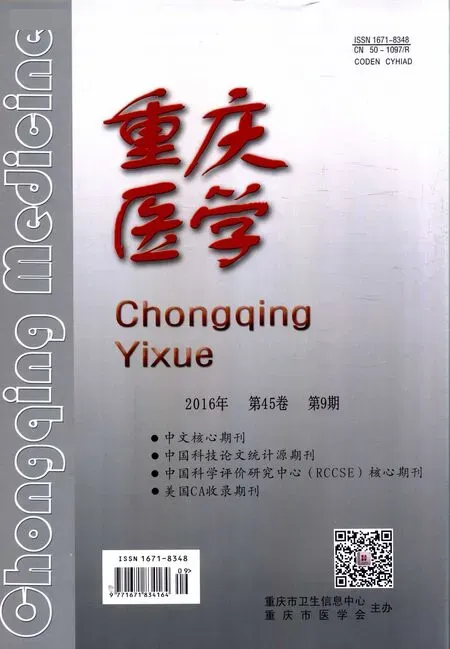右美托咪定對(duì)老年高血壓患者全麻誘導(dǎo)氣管插管應(yīng)激反應(yīng)的影響
鄭永超,黃 燕,姜 虹
(上海交通大學(xué)醫(yī)學(xué)院附屬第九人民醫(yī)院麻醉科 200011)
?
右美托咪定對(duì)老年高血壓患者全麻誘導(dǎo)氣管插管應(yīng)激反應(yīng)的影響
鄭永超,黃燕,姜虹△
(上海交通大學(xué)醫(yī)學(xué)院附屬第九人民醫(yī)院麻醉科200011)
[摘要]目的比較不同劑量右美托咪定對(duì)老年高血壓患者全麻誘導(dǎo)期間氣管插管引起的血流動(dòng)力學(xué)反應(yīng)的影響。方法將60~75歲、ASAⅠ~Ⅱ級(jí)行全麻手術(shù)的原發(fā)性高血壓患者60例,分為3組,D1、D2組和對(duì)照組(C組),每組20例。D1、D2組于麻醉誘導(dǎo)前15 min,采用微量泵將4 μg/mL的右美托咪定分別以0.2、0.6 μg/kg劑量靜脈泵入,在10 min內(nèi)完成;C組以同樣方法泵入0.9%氯化鈉溶液。分別記錄3組患者在試驗(yàn)用藥前(T0)、誘導(dǎo)前(T1)、氣管插管前(T2)、插管后1 min(T3)、5 min(T4)的平均動(dòng)脈壓(MAP)、心率(HR)、血氧飽和度(SpO2)值。同時(shí)檢測(cè)血漿去甲腎上腺素(NE)和腎上腺素(E)值。結(jié)果與用藥前相比,D2組MAP在誘導(dǎo)前明顯降低(P<0.05),C組和D1組則無(wú)明顯變化(P>0.05);D2組HR在插管后1 min明顯減慢(P<0.05),而C和D1組HR在插管后1 min顯著增快(P<0.05)。與C組相比,D2組在誘導(dǎo)前、插管前、插管后1 min、插管后5 min MAP和HR均明顯降低(P<0.05),SpO2僅在誘導(dǎo)前有所下降(P<0.05);D1組各個(gè)時(shí)點(diǎn)的MAP、HR、SpO2與C組相比均無(wú)明顯差異(P>0.05)。與T0相比,T1時(shí)D2組血漿NE和E值降低(P<0.01);T3時(shí)C、D1組血漿NE和E值升高,D2組則降低(P<0.01)。與C組相比,T1和T3時(shí)D2組血漿NE和E值均降低(P<0.01)。結(jié)論靜脈注射右美托咪定可安全抑制老年高血壓患者全麻誘導(dǎo)時(shí)氣管插管引起的血流動(dòng)力學(xué)變化,維持老年高血壓患者全麻誘導(dǎo)及氣管插管期間循環(huán)功能穩(wěn)定。并且0.6 μg/kg的右美托咪定比0.2 μg/kg能更加有效抑制氣管插管引起的應(yīng)激反應(yīng)。
[關(guān)鍵詞]高血壓;右美托咪定;氣管插管;全身麻醉
右美托咪定(dexmedetomidine,DEX)是一種新型高選擇性α2腎上腺素受體(α2AR)激動(dòng)劑,有較強(qiáng)的鎮(zhèn)靜、抗焦慮、鎮(zhèn)痛效應(yīng),且無(wú)呼吸抑制,已獲準(zhǔn)用于氣管插管及短期機(jī)械通氣期間的鎮(zhèn)靜[1-3]。因此,DEX具有潛在的降低刺激引起的高血壓、心動(dòng)過(guò)速的作用,理論上對(duì)老年高血壓患者誘導(dǎo)及氣管插管期間的血流動(dòng)力學(xué)穩(wěn)定有益。本研究旨在觀察不同劑量的DEX對(duì)老年高血壓患者全麻誘導(dǎo)期間氣管插管引起的血流動(dòng)力學(xué)反應(yīng)的影響。
1資料與方法
1.1一般資料選取2014年1~12月本院行全麻手術(shù)的原發(fā)性高血壓患者60例為研究對(duì)象,其中男36例,女24例,年齡60~75歲,體質(zhì)量50~80 kg,ASAⅠ~Ⅱ級(jí)。所有患者均無(wú)精神病史,術(shù)前檢測(cè)肝、腎功能均正常,已排除明顯心肺疾病、內(nèi)分泌疾病、繼發(fā)性高血壓、服用鎮(zhèn)靜催眠藥、煙酒或藥物成癮、過(guò)度消瘦或肥胖。患者術(shù)前評(píng)估均無(wú)困難氣道,全部采用快誘導(dǎo)經(jīng)口氣管插管。將60例患者隨機(jī)分為對(duì)照組(C組)和DEX組(D1、D2組),每組各20例。3組患者性別、年齡、體質(zhì)量、病程長(zhǎng)短無(wú)明顯差異(P>0.05)。
1.2麻醉方法術(shù)前患者常規(guī)禁飲、禁食。患者入手術(shù)室后,常規(guī)監(jiān)測(cè)心電圖、無(wú)創(chuàng)血壓、心率(HR)和血氧飽和度(SpO2),并進(jìn)行右橈動(dòng)脈穿刺置管,監(jiān)測(cè)有創(chuàng)動(dòng)脈血壓和平均動(dòng)脈壓(MAP),并建立靜脈通道。3組患者麻醉誘導(dǎo)方法一致,首先予面罩吸100%純氧,靜脈注射咪達(dá)唑侖0.04 mg/kg、芬太尼2 μg/kg、丙泊酚2 mg/kg、順阿曲庫(kù)銨0.2 mg/kg快誘導(dǎo),同時(shí)進(jìn)行人工輔助通氣。誘導(dǎo)藥物注射完3 min后行氣管插管,術(shù)中吸入1.5%~2%七氟烷,間斷追加順阿曲庫(kù)銨0.05 mg/kg、芬太尼0.05~0.1 mg維持麻醉。于誘導(dǎo)前15 min,D1、D2組采用微量泵將DEX分別以0.2、0.6 μg/kg劑量靜脈泵入,在10 min內(nèi)完成;C組以同樣方法泵入等容積的0.9%氯化鈉溶液。分別記錄3組患者試驗(yàn)用藥前(T0)、誘導(dǎo)前(T1)、氣管插管前(T2)、插管后1 min(T3)、5 min(T4)的MAP、HR、SpO2值。分別留取同時(shí)段靜脈血5 mL(0.1%肝素抗凝),立即冷卻,于30 min內(nèi)200 r/min離心10 min,收集血漿,并于-20 ℃保存,用高壓液相色譜儀檢測(cè)血漿去甲腎上腺素(NE) 、腎上腺素(E)值。

2結(jié)果
2.1MAP變化與T0相比,D2組中MAP在T1、T2、T4都降低,差異有統(tǒng)計(jì)學(xué)意義(P<0.05);C組和D1組中MAP在T2和T4降低,差異有統(tǒng)計(jì)學(xué)意義(P<0.05);3組患者M(jìn)AP在T3均升高,差異有統(tǒng)計(jì)學(xué)意義(P<0.05)。與C組相比,D2組在T1~T4 MAP均較低,差異有統(tǒng)計(jì)學(xué)意義(P<0.05);而D1與C組相比MAP各時(shí)點(diǎn)差異無(wú)統(tǒng)計(jì)學(xué)意義(P>0.05)。3組患者全麻誘導(dǎo)及氣管插管期間MAP變化見(jiàn)表1。
2.2HR變化與T0相比,D2組中HR在T1~T4均明顯減慢,差異有統(tǒng)計(jì)學(xué)意義(P<0.05);D1組和C組中HR在T2、T4明顯減慢,在T3則明顯增快,差異有統(tǒng)計(jì)學(xué)意義(P<0.05)。與C組相比,D2組中HR在T1~T4均明顯減慢,差異有統(tǒng)計(jì)學(xué)意義(P<0.05);而D1組HR在各時(shí)點(diǎn)與C組相比均無(wú)差異(P>0.05)。3組患者全麻誘導(dǎo)及氣管插管期間HR變化見(jiàn)表2。
2.3SpO2變化與T0相比,3組患者SpO2在T1~T4均顯著升高,差異有統(tǒng)計(jì)學(xué)意義(P<0.05)。與C組相比,D2和D3組患者SpO2在T1顯著降低,差異有統(tǒng)計(jì)學(xué)意義(P<0.05);D1組患者則在各個(gè)時(shí)點(diǎn)均無(wú)明顯差異(P>0.05)。3組患者全麻誘導(dǎo)及氣管插管期間SpO2變化見(jiàn)表3。
2.4血漿NE和E值變化與T0相比,T1時(shí)D2組NE和E值降低(P<0.01);T2時(shí)3組NE和E值均降低(P<0.01);T3時(shí)C、D1組NE和E值升高,D2組均降低(P<0.01)。與C組相比,T1和T3時(shí)D2組NE和E值均降低(P<0.01)。3組患者全麻誘導(dǎo)及氣管插管期間血漿NE和E值變化見(jiàn)表4。

表1 3組患者全麻誘導(dǎo)及氣管插管期間MAP變化±s)
*:P<0.05,**:P<0.01,與C組比較;+:P<0.05,++:P<0.01,與T0比較。

表2 3組患者全麻誘導(dǎo)及氣管插管期間HR變化±s)
**:P<0.01,與C組比較;+:P<0.05,++:P<0.01,與T0比較。

表3 3組患者全麻誘導(dǎo)及氣管插管期間SpO2變化±s)
*:P<0.05,與C組比較;+:P<0.05,++:P<0.01,與T0比較。

表4 3組患者全麻誘導(dǎo)及氣管插管期間血漿NE和E值變化±s,ng/L)
**:P<0.01,與C組比較;++:P<0.01,與T0比較。
3討論
DEX是美托咪定的右旋異構(gòu)體,屬咪唑類衍生物。它的鎮(zhèn)靜效應(yīng)是由激動(dòng)中樞腎上腺能受體亞型而產(chǎn)生的。與可樂(lè)定相比,其受體的選擇性(α2/α1為1 620∶1)遠(yuǎn)高于可樂(lè)定(α2/α1為300∶1)[4],效價(jià)比可樂(lè)定高3倍。藍(lán)斑核是其產(chǎn)生抗焦慮鎮(zhèn)靜作用的關(guān)鍵部位,有別于其他鎮(zhèn)靜劑,該藥能作用于此部位產(chǎn)生可喚醒的鎮(zhèn)靜,配合醫(yī)師的指令,體現(xiàn)更好的合作性。
高血壓是老年人群中常見(jiàn)的疾病之一,也是引起患者手術(shù)期間和術(shù)后心腦血管意外的主要危險(xiǎn)因素。麻醉誘導(dǎo)時(shí)進(jìn)行氣管內(nèi)插管,會(huì)通過(guò)交感和交感-腎上腺素反射,引起高血壓、心動(dòng)過(guò)速[5]。尤其在老年高血壓患者的麻醉誘導(dǎo)中,如發(fā)生這些反應(yīng),則會(huì)增加心肌氧耗和血管壓力,有可能導(dǎo)致心力衰竭、腦梗死等嚴(yán)重并發(fā)癥的發(fā)生。
老年高血壓患者在全麻圍插管期必須給予恰當(dāng)評(píng)估和處理[6]。氣管插管時(shí)如果麻醉鎮(zhèn)靜深度不夠會(huì)導(dǎo)致患者血壓、心率升高,血漿兒茶酚胺濃度升高等氣管插管應(yīng)激反應(yīng),增加了患者手術(shù)的風(fēng)險(xiǎn),影響患者預(yù)后。抑制插管反應(yīng)是麻醉誘導(dǎo)的目標(biāo)之一。DEX可以通過(guò)中樞交感神經(jīng),阻滯和興奮外周突觸前α2受體,減少兒茶酚胺的釋放,產(chǎn)生降血壓作用[7]。Kunisawa等[8-11]報(bào)道術(shù)前給予DEX,能夠降低氣管插管及手術(shù)引起的血漿腎上腺素、去甲腎上腺素、皮質(zhì)醇和內(nèi)啡肽升高反應(yīng),從而降低氣管插管或其他手術(shù)刺激。
本研究結(jié)果表明,與用藥前基礎(chǔ)值相比,D2組MAP誘導(dǎo)前、氣管插管前、氣管插管后5 min均明顯降低,C組和D1組MAP僅在氣管插管前和氣管插管后5 min降低,3組MAP在氣管插管后1 min均明顯升高;D2組HR在用藥后的4個(gè)時(shí)間點(diǎn)均減慢,而C組和D1組HR在氣管插管前和氣管插管后5 min下降,氣管插管后1 min則明顯增快。血漿NE和E值檢測(cè)結(jié)果發(fā)現(xiàn)D2組的血漿兒茶酚胺水平在誘導(dǎo)前和氣管插管后1 min較用藥前均降低,而C組和D1組的血漿兒茶酚胺水平在氣管插管后1 min升高。以上結(jié)果顯示在老年高血壓患者全麻誘導(dǎo)前應(yīng)用DEX能抑制血漿中兒茶酚胺的釋放,產(chǎn)生一定的降血壓和心率的鎮(zhèn)靜效應(yīng),并能抑制氣管插管引起的心率增快等應(yīng)激反應(yīng),維持氣管插管時(shí)的血流動(dòng)力學(xué)穩(wěn)定。
與對(duì)照組相比,D2組患者應(yīng)用0.6 μg/kg的DEX后,在誘導(dǎo)前、插管前、插管后1 min、插管后5 min MAP和HR均明顯降低,SpO2僅在誘導(dǎo)前有所下降;而D1組各個(gè)時(shí)間點(diǎn)的MAP、HR、SpO2與C組相比均無(wú)明顯差異。D2組患者在應(yīng)用0.6 μg/kg的DEX后,血漿兒茶酚胺水平在誘導(dǎo)前和氣管插管后1 min均明顯降低。因此在老年高血壓患者全麻誘導(dǎo)前提前靜脈給予0.6 μg/kg的DEX相比,0.2 μg/kg能更加有效地抑制氣管插管引起的血壓升高和心率增快等應(yīng)激反應(yīng),且比較安全,未出現(xiàn)包括低血壓、高血壓、惡心、心動(dòng)過(guò)緩、口干等不良反應(yīng)[13]。
對(duì)于血流動(dòng)力學(xué)處于代償期或者已經(jīng)不穩(wěn)定的患者在全麻誘導(dǎo)前應(yīng)用DEX要注意其潛在的危險(xiǎn),在給予DEX前必須全面評(píng)估患者的容量狀態(tài)和心臟傳導(dǎo)疾病。總之,DEX作為全麻誘導(dǎo)前的用藥,能安全有效的抑制氣管插管時(shí)的應(yīng)激反應(yīng),保持老年高血壓患者氣管插管時(shí)的血流動(dòng)力學(xué)穩(wěn)定,對(duì)降低高血壓患者圍術(shù)期并發(fā)癥的發(fā)生率有一定潛在意義。
參考文獻(xiàn)
[1]Schaffrath E,Kuhlen R,Tonner PH.Analgesia and sedation in intensive care medicine[J].Anaesthesist,2004,53(11):1111.
[2]Phan H,Nahata MC.Clinical uses of dexmedetomidine in pediatric patients[J].Pediatric Drugs,2008,10(1):49-69.
[3]Penttila J,Helminen A,Anttila M,et al.Cardiovascular and parasympathetic effects of dexmedetomidine in healthy subjects[J].Can J Physiol Pharmacol,2004,82(5):359-362.
[4]Szumita PM,Baroletti SA,Anger KE.Sedation and analgesia in the intensive care unit:evaluating the role of dexrmedetomidine[J].Am J Respir Crit Care Med,2007,64(1):37-44.
[5]Neukirchen M,Kienbaum P.Sympathetic nervous system evaluation and importance for clinical general anesthesia[J].Anesthesiology,2008,109(6):1113-1131.
[6]Dogru K,Arik T,Yildiz K,et al.The effectiveness of intramuscular Dexmedetomidine on hemodynamic responses during tracheal intubation and Anesthesia induction of hypertensive patients:a randomized,double-blind,placebo-controlled study[J].Curr Ther Res Clin Exp,2007,68(5):292-302.
[7]Gerlach AT,Dasta JF.Dexmedetomidine:an updated review[J].Ann Pharmacother,2007,41(2):245-252.
[8]Kunisawa T,Nagashima M,Hanada S,et al.Awake intubation under sedation using target-controlled infusion of dexmedetomidine:five case reports[J].J Anesth,2010,24(5):789-792.
[9]Kunisawa T,Nagata O,Nagashima M,et al.Dexmedetomidine suppresses the decrease in blood pressure during anesthetic induction and blunts the cardiovascular response to tracheal intubation[J].J Clin Anesth,2009,21(3):194-199.
[10]Hall JE,Uhrich TD,Barney JA,et al.Sedative,amnestic,and analgesic properties of small-dose dexmedetomidine infusions[J].Anesth Analg,2000,90(3):699-705.
[11]Menda F,K?ner O,Sayin M,et al.Dexmedetomidine as an adjunct to anesthetic induction to attenuate hemodynamic response to endotracheal intubation in patients undergoing fast-track CABG[J].Ann Card Anaesth,2010,13(1):16-21.
[12]Tobise F,Toyoshima Y,Kawana S.Effect of dexmedetomidine on hemodyn amics in pediatric patients following cardiac surgery[J].Masui,2007,56(4):409-413.
Influence of dexmedetomidine on intubation stress reactions under general anesthesia induction in senile hypertension patients
Zheng Yongchao,Huang Yan,Jiang Hong△
(Department of Anesthesiology,Affiliated Ninth People′s Hospital,School of Medicine of Shanghai Jiaotong University,Shanghai 200011,China)
[Abstract]ObjectiveTo compare the influence of different doses of dexmedetomidine on the haemodynamic response caused by tracheal intubation during general anesthesia induction in senile hypertension patients.MethodsSixty patients with essential hypertension(EH) undergoing general anesthesia operation,60-75 years old,ASAⅠorⅡ,were randomly divided into the group D1,D2 and control group(C),20 cases in each group.4 μg /mL dexmedetomidine in the group D1 and D2 was intravenously pumped at 15 min before anesthesia induction with the doses of 0.2,0.6 μg/kg respectively and completed within 10 min;while the group C was pumped with sodium chloride injection by the same method.Mean artery pressure (MAP),heart rate (HR) and O2 saturation (SpO2) were monitored at before medication(T0),before induction(T1),before intubation(T2),at 1 min(T3),5 min(T4) after tracheal intubation.Meanwhile plasma norepinephrine(NE) and epinephrine(E) values were detected.ResultsCompared with before medication,MAP before induction in the group D2 was significantly decreased (P<0.05),however which in the group D1 and C had no obvious change(P>0.05);HR at 1 min after tracheal intubation in the group D2 was significantly decreased (P<0.05),while which in the group C and D1 was significantly increased(P<0.05).Compared with the group C,MAP and HR before induction and tracheal intubation,at 1,5 min after tracheal intubation in the group D2 were significantly decreased(P<0.05), SpO2 was significantly decreased only before induction (P<0.01);MAP,HR and SpO2 at each time points in the group D1 had no significant differences compared with the group C(P>0.05).Compared with T0,the plasma levels of NE and E at T1 in the group D2 were decreased (P<0.01);the plasma levels of NE and E at T3 in the group C and D1 were increased,while which in the group D2 were decreased (P<0.01).The plasma levels of NE and E at T1 and T3 in the group D2 were decreased compared with the group C (P<0.01).ConclusionIntravenous injection of dexmedetomidine can safely inhibit the tracheal intubation caused hemodynamic changes and keep the hemodynamic stabilization during general anaesthesia induction and tracheal intubation period in senile hypertension patients.Furthermore dexmedetomidine 0.6 μg/kg can more effectively inhibit the tracheal intubation caused stress reactions than dexmedetomidine 0.2 μg/kg.
[Key words]hypertension;dexmedetomidine;tracheal intubation;general anesthesia
doi:論著·臨床研究10.3969/j.issn.1671-8348.2016.09.021
作者簡(jiǎn)介:鄭永超(1984-),碩士,住院醫(yī)師,主要從事靜脈麻醉藥物的鎮(zhèn)靜、鎮(zhèn)痛機(jī)制研究。△通訊作者,E-mail:yongchao0110@163.com。
[中圖分類號(hào)]R614.2
[文獻(xiàn)標(biāo)識(shí)碼]A
[文章編號(hào)]1671-8348(2016)09-1220-03
(收稿日期:2015-10-08修回日期:2015-12-17)

